Cycle Tour Summer trip to Toender
2. Etape: Tønder-Sofiedal
![]()
Please wait - map data are loading
Added on 10 Jul 2013
on 08 Sep 2020
Cycle route metrics
ridden
Total distance in km
76
Cumulative elevation gain in m
172
Avg. slope uphill in %
0,23
Cumulative elevation loss in m
149
Min. height
2
Max. height
27
Information about rights to the gps-track data | |
|---|---|
Rights owner | |
Rights characteristic / license | by-sa: CREATIVE COMMONS Attribution-ShareAlike |
Link to the description of the license | |
GPX file uploaded | by Ottocolor on 13 Jul 2013
|
Track points in total
570
Track points per km (avg)
8
Start/endpoint
Start location
Tønder, Region of Southern Denmark, DK (9 m NHN)
End location
Sofiedal, Region Süddänemark, DK (24 m NHN)
ridden on
11 Jul 2013
Weather
Perfect cycling weather! Sunny all day long, 22 to 24 degrees (slightly warmer than yesterday) and light to moderate, at times fresh wind from West and Northwest. That meant headwind out to the outer levy, and then tailwind all the way to Sofiedal.
Properties
The stage was done as planned, exactly without any detours. The beginning of the stage, the tour around Tønder (partly on foot) measured 6 km.
Travel report
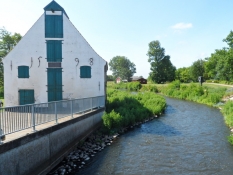
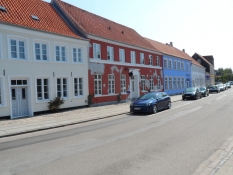
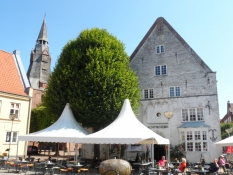
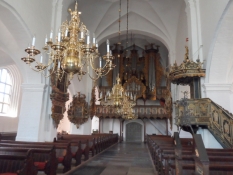
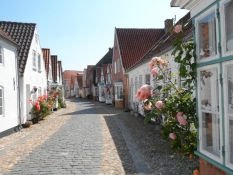
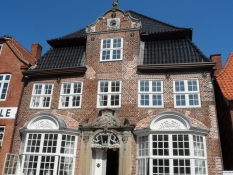
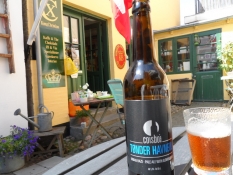
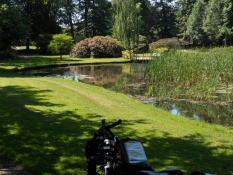
The day at Tønder campsite began with a hearty breakfast at a table-and-bench set outside the well-equipped camping kitchen. It had both a freezer and a refrigerator, so I had chilled my foodstuff. And I had 'pomle' (buns) with butter. Today's program was not that big, so I allowed myself a good rest in the sun on my inflatable mattress after breakfast. I had in fact got up very early, as I could not sleep anymore anyway.
But then it was time to pack everything together and cycle the short distance into Tønder in order to spend the morning looking at the sights in general, and savour the memories from my childhood in particular. After a few meters I was, however, already stopped by a lot of flashing blue lights and fire trucks parked on the car park of Tønder halls. First I thought it was a fire drill, but I saw smoke coming up under the roof, so I think the roof structure had caugt fire somewhere, but it wasn't dramatic, and there were only a few spectators. Next stop, again only a few meters further on, was Hostrups Hotel, where my family had gathered after my grandmother's funeral in 1982. The reader of this will now be confronted with a good deal of childhood memories in the description of the visit in Tønder, where my father comes from. He lived with his parents, my grandma and grandpa in the town a few years and it remained my grandparents' hometown until their death. Therefore, I had been visiting it many times, and part of the purpose of the visit was to look at these places. Just opposite to Hostrups Hotel, is a park beautifully situated next to Vidåen, which is extended to a lake here. At first I thought it might be the so-called 'anlech' (sønderjysk (Southern Jutland dialect) for a park), where I was sent down to play so many times during my visits to my grandmother. But it wasn't this one, I found out later. On the other side of this park, just on the other side of Kongevejen, which leads in an arc around the old town, I found Bachmann's watermill. It did not look like I remembered it, then overgrown and hidden away. Now it stood lonelye in the sun down to the river, which is quite wide here. From here it's not far to the former ship quay, the Skibbroen. This was once Tønder's port street, but where the port had been, there was now a large parking lot. However, there was a large board, which told of the towns plans to restore its harbour as it was before if was filled up in the 1930s. Then it had long lost its importance as a port due to silting and difficult access along Vidåen through the marshes. But now it was to be all rebuilt and to that purpose the town tries to raise money through selling items like port coffee, port beer and others. The beer could be purchased at a certain Chr.X in Vestergade, wherever that was. But it was certainly identified by me as a target now. The street to the right I had to visit as it was Skibbrogade. Here my father grew up in a house, which is now No 17. He described it in detail in his memoirs, which I let go through the mind. There had lived four families in the house, and he had described it as very cramped. But my dad had not lived here for long, since he quickly became an 'adult' and already as a 15-year-old boy became an agricultural student at Rønhave on Als, which, after many detours by my Daddy, was to be my own home island. The house seemed very plain to me today. In contrary to the idyllic Uldgade, as I walked through it. Here all Tønder's charm is gathered with the cute little gabled houses with bay windows in front, where the wives and girls sat and made lace. Making lace turned into a whole industry in Tønder, which in the 1600s was on the way down after losing its harbour. Tønder-lace came into fashion, and it brought the town considerable wealth especially in the 18th century. Many beautiful town houses with ornately carved wooden doors, especially on the main street Storegade and the rich furniture and equipment in the church of Kristkiren testify to this. I just enjoyed it in the glorious sunshine and with blooming roses. Now it was time for a visit to the Square. Here stands the statue of 'kagmanden' but his importance to the town I did not not investigate. Instead, I took a picture of the abbey cafe Klostercafeen (one of the most beautiful town houses) with a tree in front and the church in the background. This photo I just wanted to take, as my father had painted the motive and it hung in his 'hobby room' in my childhood home in Spang outside Sønderborg for all the years. I noted that the tree had grown much larger in the meantime, and Klostercafeen had canopies in front of it for outdoor seating. Now it was obvious to visit the church. First, I read about it on a board outside. It is not nearly as old as the city, which dates back to the 1200s when there stood a now demolished Laurentian church further west. The Kristkirken dated back to the 1500s and is built in a peculiar style which is neither Gothic or Renaissance. Especially the tower with its funny lantern-like small hatches up the spire, clad in wooden shingles. Inside the very rich furnishings immediately fell into my eyes. Especially a really magnificent renaissance rood altar with paintings. It separates the choir from the nave, as is often seen in German churches. But Tønder is indeed the most German town in Denmark, and the congregation is divided, so there are church services in both languages. Many epitaphs (grave monuments) and the very large chandeliers help to give a rich impression. Both inside and outside peace reigned majestically. Not many people were to be seen, even if the weather and the season particularly invited to roam around. My trip continued now along Storegade, which is the town's pedestrian and shopping street. I looked for grand houses and enjoyed the environment. Especially the beautiful ornate doors were a pleasure. Storegade continues into Vestergade, and that was lucky, as I now yearned for a harbour beer, which is served in No. 66, Vesterdade. The store Chr.X is to be reached through a gateway, and it was just tremendously cosy in the back yard with old signs, a large flag and a oldfashioned garden furniture. There I enjoyed a harbour beer, after I had everything explained to me inside the store, which smelled wonderfully of coffee and spices. The beer was brewed by Anders Coisbo in Morud on the island of Funen. It was a pale ale, one of the very modern, in my opinion a bit overrated, beer types, but it was a great pleasure to enjoy it in the backyard.
Now I would seek out the places where my grandmother lived in her older age, because I remembered her only being old. It is no exaggeration to say that she was not a good grandmother for my siblings and me, because she did not like children. They behaved noisily and brought disorder into her, for us, perfect seeming everyday life. The last years she lived in Leos Allé No. 8, one of four similar appearing palatial houses in front of which I remember a photograph taken of her. But especially No. 8 had been completely redesigned, as it was now a part of a care center. Back then it was just protected housing only for elderly people. The years before she had lived in No. 2, Schradersvej, only a long stone's throw away. Here she had partly also had my aunt Irma, called Irmi, living with her. She had Down's syndrome and was therefore disabled, why she had been living in psychiatric hospitals in Ribe (Ribelund) and Løgumgårde. The most vivid memories from 'Omi', as we called her, stem form here in the small concrete element semidetached on Schradersvej. Back then it was concrete colored and the interior was a masterpiece of twee petty bourgeois lifestyle with everything you can get in knickknacks. Everything was then incredibly proper, so neither my father and I felt very much at home in the little living room. Daddy always had to work in her garden when he visited her, and innumerable were the visits here. The main attraction was my grandmother's color TV. At home it was only black and white. Now the house was painted in an ugly green color and the box hedges were gone. I heard a young man talking to himself (and his moped, as it turned out) through an open backdoor. I went closer and along the path to No. 4 Here lived a deeply regrettable man named Hjort (pronounced Jååt) as we are always told in every detail by my grandma, what he had been doing. It was so miserably boring, I can recall. Later on Leos Allé there was one 'Frau Bohsen' who comitted a lot of mishaps with unclean toilets and all sorts of gossip. Well, before the reader falls asleep, I will tell you that back in the present day, the young man, called 'Henrik Rasmussen' I could read on the door sign, came out of the backdoor pulling his moped, lamenting the fact that it would not work inspite his numerous attemts to start the engine. He paid no attention to me at all. I thought that if Omi knew there was repaired a moped in her outhouse... Well, it's 30 years since she died. Yet her, Irmi's and my grandfather Andreas' gravesite (who died in 1967, and whom I almost can not remember) was already levelled. I knew that already, so I biked only to the cemetery along Ribe road and stopped at the churchyard gate. Now it was time for a bite of lunch in the form of my packed lunch. It could appropriately be consumed in a parked, known to us as 'e anlech', which I found behind some new houses in Blegen. Into this park we children were often sent when we got bored too much at my grandmother's or too heavily troubled her extremely anxious disposition. I found the playground with new tools and the pond, where I had been playing then. Now I ate my lunch on a bench overlooking the neatly kept 'anlech'. Afterwards it was time to turn my back to Tønder by cycling to Møgeltønder and into the marshland.
Information about copyright | |
|---|---|
Rights characteristic / license | by-sa: CREATIVE COMMONS Attribution-ShareAlike |
Link to the description of the license | |
taken over / edited on | 25 Jul 2013
|
taken over / edited by |
|
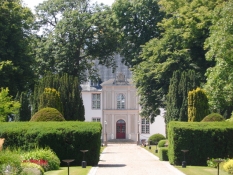
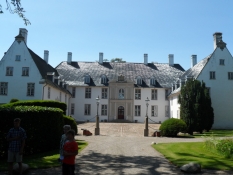
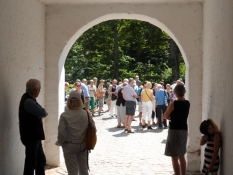
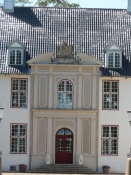
I just rounded the church again into Noerregade and Adelgade and entered Struck's Allé. At the corner of Kongevejen my eyes fell on a music venue, called Hagge's. In my childhood it was a hotel where we had celebrated my aunt Irmi's 50th birthday (I think it was). Struck's Allé was one big road works, which, however, I managed to pass. My plan was to follow cycle route 8 completely to Rudbøl. First stop was Møgeltønder. There was quite a strong headwind. I first took a picture through Schakenborg palace's east gate along the entire axis down to the main building. Previously, it was very overgrown here. On a boardsign I found that there was to be a tour of the palace gardens fifteen minutes later, so I went straight down to the gatehouse, from which it started. About 50 people were already waiting here, but I was lucky and got one of the last tickets. And we all joined in on a rotunda in the garden in front of the castle where our guide, an elderly lady clearly of German descent, told us about the palace's history as Count Schack's Renaissance palace and its predecessor, a completely demolished medieval castle and about the people's gift to Prince Joachim and Princess Alexandra's wedding in 1995, which consisted of an exterior renovation of the castle as well as a new construction of the palace garden. We stood in the shade, but the roof's black glazed stones glistened in the sun, and everything looked nice and cared for, albeit completely abandoned. In the garden there was more life when gardeners trimmed hedges and looked after the beautiful roses. We went down to the East Gate, where I had been before and saw the big bronze crown and the 'birth trees'. Each of Prince Joachim's children, two with Alexandra and two with Princess Marie, have their own tree, planted when they were born. Soon we were back at the gatehouse and were locked outh through the gate again.
Information about copyright | |
|---|---|
Rights characteristic / license | by-sa: CREATIVE COMMONS Attribution-ShareAlike |
Link to the description of the license | |
taken over / edited on | 25 Jul 2013
|
taken over / edited by |
|
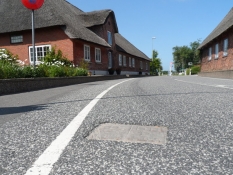
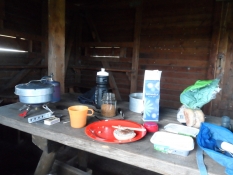
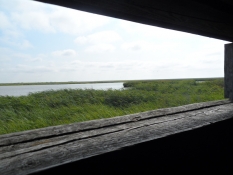
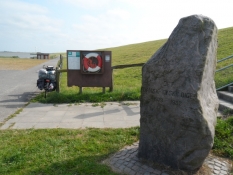
Now it seemed to me that I was running out of time, so I did not do much of the romantic cobbled Slotsgade with the beautiful, typical thatched half-timbered houses, but rode quickly out into the marshes heading southeast. Now Rudbøl and the peculiar border to Germany were my targets. I missed water in my bottle, so I 'tanked' in Rudbøl Grænsekro. The hostel had been completely abandoned. Soon I reached the bridge over Rudbøl lake called Ruttebüller See in German, which is divided between Denmark and Germany, and in order to ensure the fishermen on both shores access to the lake, the border runs down the middle of the road for an approx. 150 meter long section, so that the houses on your left, coming from Rudbøl, belong to Germany and their opposite neighbours live in Denmark. A stone in the middle of the road with the letters D (for Denmark) and DRP (Deutsches Reich Preußen) marks the exact place of the boundary. It's certainly Denmark's strangest border stretch. On the German side the village is called Rosenkranz. Soon I was completely in Germany, but turned immediately to the right in order to cycle out to the North Sea and the advanced dyke on the German side, where there is a tarmac road all the way out. You cycle along the border so that the meadows to the right on the other side of a ditch and a fence belong to Denmark, while the houses on the left are located in Germany. The wind was now blowing fresh from the west, and I could feel I was in need for a good coffee break by now. In the wide open landscape, though, it was impossible to try to turn on my gas burner, as it requires some shelter, even though I have bought a windshield for it. Shortly before my goal of the new dyke, however, a very lucky and wonderful surprise turned up in the form of a small grove and the sign "Beobachtungshütte" which led down through the grove. Great! A bird hide with lids to be opened (and I did just let those on the windward side be shut) as well as benches and a table that could be moved to one of the benches. Now I could make a whole coffee table, and so I did. I had buns with Marabou chocolate with licorice pieces in. Exquisite! The view out of the south door was also fine. It showed the new Rickelsbüller Koog, as the new land between the old and the new dike is called on the German side. In the distance I could see trains run to and from Sild on the embankment with cars loaded on board. This is the way the Germans get to Sild or Sylt, as they call their preferred holiday island. After the coffee break, I headed out for the new dike and looked at the stone that stands in memory of the effort of building it. It came about as a joint German-Danish project after the flood in January 1976 which flooded large parts of the marshes and while which the town of Tønder was evacuated. I remember my grandmother was on Abild school north of town. In 1981, the new dyke was finished, just in time to stand against the next storm in November that year. The area between the levies was not cultivated or just drained, as it had always been done, and the nature has benefited from it. On the Danish side the area is called Margrethe Kog after the queen. But the lack of salt water and tidal cycle has nevertheless brought great changes here. I climbed straight up on the dike and enjoyed the view out over the North Sea. There was high tide, I could see. I had now reached the westernmost point of the stage, and, because of the, out here at least, fresh westerly wind, I was happy about that. Now it went back to the old dike and a small part towards Hojer before I swung down to Rudbøl for the second time that day. I was again running out of drinking water, so I asked the lady at the hostel to fill my bottle up. And then I asked her about the missing stork, which I knew had previously bred in Rudbøl. And got a long story about how the so-called stork expert, according to the hostel's hostess, had done everything he could to make the stork flee away from Rudbøl. Among a lot of mistakes he had lined the stork's nest with peat, after which the young storks drowned in the nest during a heavy downpour. Afterwards he had recommended to let the dead young storks remain in the nest over the winter, what had been quite disastrous. He had also made the stork abandon its nest on the old townhall of Ribe. A sad and literally incredible story. She spoke the tidiest sønderjysk dialect with Tønder-accent. But apart from that she seemed entirely unpleasant to me with her negative stories. Well, I got me water (with a sour face), and then I made it across the peculiar border again. This time I swung to the left after it and cycled to Aventoft. Here, my father and I had shopped many times for my grandmother, and the village still seems to be the inhabitants' of Tønder's favourite shopping place across the border. I was content with just a little for my supper, including a Paulaner Salvator beer. Yummy. So I slipped across the border again and found the church in Uldal. But the toilet was not to be found. But then I could luckily use one at the farm next door. Now it was beginning to get late, and there were still almost 30 kilometres to Sofiedal, but as the wind blew well from behind, it took only a half hour, constantly on the Danish side of the border, since on the German side a dull autostrada without cycle lane progresses, where the Germans go fast in their cars. So I enjoyed to ride on the Danish side, and stayed there, until I had reached my goal, the tent site in the small hamlet of Sofiedal.
Google Oversæt til virksomheder:OversætterkitWebsiteoversætterFind nye.
Information about copyright | |
|---|---|
Rights characteristic / license | by-sa: CREATIVE COMMONS Attribution-ShareAlike |
Link to the description of the license | |
taken over / edited on | 25 Jul 2013
|
taken over / edited by |
|
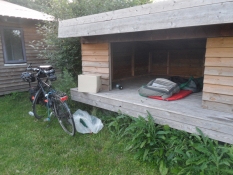
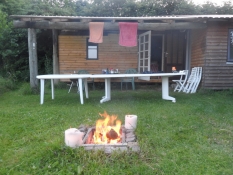
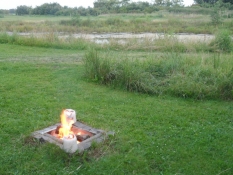
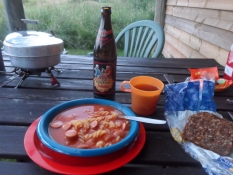
I had called ahead and alerted the owner of the campsite in Sofiedal about my late arrival. At about a quarter past nine I arrived and was wecomed by a woman and her son. They led me right to the back of their compound ground over at stretch of neatly cut grass into a little outdoor paradise with a few wooden huts with a bathroom and a refrigerator, a newly built shelter, and a fireplace overlooking a small lake with a fold with two horses behind. Idyllic'! The shower wasn't working, so I immediately began to boil water to stripwash myself. The towel I used as a wash cloth, and so it worked out quite well. Then I lit a fire using the firewood, I had been shown plus a little more, I found in the bushes behind the shelter. There was also a small cottage called 'mother in law's wagon'. Ha ha. She couldn't sleep any further away from their house. My supper tasted especially tasty that evening: Tomato soup with pasta and Vienna sausage pieces, bread and Salvator. A very small feast with liquorice sweets afterwards. And with the flames of the bonfire as long as I could find more firewood. When it was pitch dark, I went down and 'talked' to the horses. They could drink water in the lake. They seemed to love one another very deeply, and I liked that. Now it was time to hit the hay, and since I had not pitched my tent, it was in the shelter. I had never slept in a such, and I must say I'll not do it so soon again. In the morning it grew awfully cold, and although I crept as far down into my sleeping bag, as I could, I turned cold on the upper body. Perhaps I should have slept at the back instead of the head toward the light. Well, I did not feel I had slept well that night.
Information about copyright | |
|---|---|
Rights characteristic / license | by-sa: CREATIVE COMMONS Attribution-ShareAlike |
Link to the description of the license | |
taken over / edited on | 25 Jul 2013
|
taken over / edited by |
|
